Want to localize your website? If so, you’ll need to figure out how you will structure the URL to distinguish between the languages and the regions that you want to target. So what is the best URL structure for international SEO? What are the available methods? And what are the pros and cons of each method?
Unfortunately, the ideal URL structure is not the same for every situation. Choosing the best URL structure for a localized website takes careful thought and effort in order to find a solution that promotes international SEO.
So in this guide we’ll help you examine the pros and cons of each URL structure option and decide which type of structure makes the most sense for your multilingual website.
Summary
A foundational step to building a multilingual website is choosing the best URL structure for international SEO. In this article we explain all your options for indicating language and region in the URL structure. We also set out the pros and cons and things you should consider about each method.
Table of Contents
Factors in Choosing URL Structure for International SEO
What Are the Methods for Structuring Multilingual Website URLs?
Factors in Choosing a URL Structure for International SEO
What factors might influence your choice? There are actually a few factors to consider.
- Region vs. language
- Cost and effort
- Corporate structure/
governance
We’ll explain how these factors affect your decision in the following sections.

The best URL structure for your multilingual website depends on your goals, budget, and general situation.
Region vs. language
First, you need to decide whether you are targeting a region or a language.
Remember that region and language are not the same thing. For example, you might translate your website to Spanish in order to reach US Hispanics. In that case your US English site and your Spanish site are targeting the same region—the USA—but different languages.
On the other hand, you might have a store in Mexico and then another store in Colombia, and you need to target those regions separately. In this case you would have one language—Spanish—but two different regions.
Cost and Effort
Second, you may need to consider how much cost and effort you are willing to put forth in order to produce your multilingual site. If you can allocate only a minimal budget and effort, then you’ll find that some strategies will be much more cost effective than others.
Corporate Structure/Governance
Third, the corporate structure, or how the parts of the company are managed, might be another factor.
A company might have one legal entity and serve all its markets from a central office with a low amount of customization for target markets. On the other hand, another company might have several legal entities all serving different markets with a high degree of independence from each other.
These two companies might make different choices on how to structure the URL of their multilingual websites.
So to learn how these factors might affect your choice of URL structure for your localized website, keep reading.
Want to Localize a Website?
We’ve localized web content for 20 years. Tell us about your project for a free quote and consulting with one of our localization specialists.
What Do You Want to Localize?
In this article we will:
- Give some definitions.
- List the strategies and explain each one.
- Share some points to consider.
Download This Article as an eBook!
Want to take this article to read with you on the go? Want to share the info with others on the team?
Download the eBook
Definitions—What’s in a [Domain] Name?
Do you find URLs confusing? Let’s clear up the fog!
URL stands for Uniform Resource Locator. That’s the address of a webpage. It’s the text that you type into the bar at the top of your browser to navigate to a website.
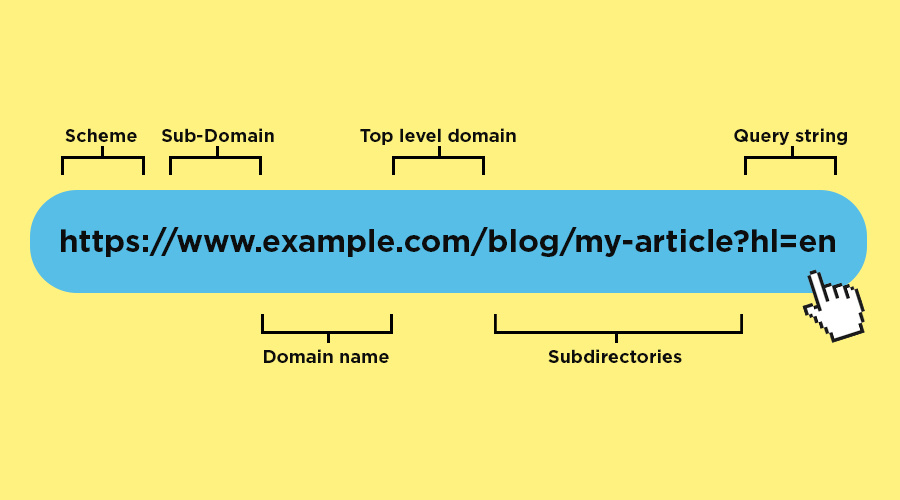
This diagram shows the various parts of a URL.
Let’s look at the main parts of a URL. If we look at this example URL (https://www.example.com/
- The scheme (protocol)
- The subdomain (child domain)
- The domain
- The top level domain
- The subdirectories (file path)
- A query string (URL parameter)
We’ll explain each of these in the following sections.
Scheme (Protocol)
https://www.example.com/
The scheme is not important for the sake of this article, but since we’re talking about URLs, here’s the definition. According to IBM, “The scheme identifies the protocol to be used to access the resource on the Internet.” In other words, it tells the computer how to open the link.
In web addresses they are http: or https:, which tell your computer that the link you clicked on should open in a web browser. Other schemes include tel: (to call a number) and mailto: (to create an email to the email address).
Subdomain (Child Domain)
https://www.example.com/
The subdomain, also called a “child domain,” is the prefix of a domain name. It’s used to divide websites into major sections.
It’s almost like your domain name is the name of the apartment complex and the sub-domain is the apartment number.
The most common subdomain is www (e.g. www.example.com), but you have probably seen other subdomains as well such as blog (e.g. blog.example.com), support (e.g. support.example.com), or shop (e.g. shop.example.com).

Subdomains are often used to divide websites into major sections such as blog, support, or store sections.
Domain
https://www.example.com/blog/my-article?hl=en
Every server serving a website to people on the Internet has a number to identify it. That’s the IP address. But numbers are hard for people to remember, so we associate a word with that number. That word is the domain name.
The domain is the human readable word that identifies your website.
Top-Level Domain (TLD)
https://www.example.com/blog/my-article?hl=en
The top-level domain or TLD is the suffix of a domain name. It’s the extension on the end after the period.
The most common TLDs include .com, .net, and .org. These are gTLDs or Generic Top-Level Domains.
What is more relevant to this article are ccTLDs or Country-Code Top-Level Domains. They include .cn (China), .mx (Mexico), .es (Spain), .uk (United Kingdom), .ca (Canada), and so on.
Sub-Directory
https://www.example.com/
Subdirectories divide your website into parts. If you were to imagine that your website is a file cabinet, the subdirectories would be like folders in that cabinet.
They are just like the file path for a file on your computer (e.g. C:\Users\darren\Documents). They are used to organize the content on your site into different sections and individual pages.
Query String (URL Parameter)
https://www.example.com/
Query strings or URL parameters are text strings at the end of a URL after a question mark. They are used to either change the content of the page or to track some information about the users.
So for example, a language parameter could be added to change the language on the webpage. Or a UTM code could be added to a link so that webmasters will know where users came from when they clicked the link.
Get your free UTM Code Builder Spreadsheet Template!
Do you use UTM codes to track visitors to your website? Have a hard time remembering all your codes?
Download your UTM Builder Spreadsheet Tool(No signup required.)
What Are the Methods for Structuring Multilingual Website URLs?
There are 5 methods for structuring multilingual website URLs for international SEO.
- Use completely different domains: e.g., https://cfmotousa.com/ vs. http://www.cfmoto.com/
- Use ccTLDs (cc Top Level Domains): e.g., http://www.google.cn/ vs. http://www.google.es/
- Use subdomains: e.g., https://cn.getresponse.com/ vs. https://www.getresponse.com/
- Use subdirectories: e.g., https://www.bbc.com/
zhongwen/ & https://www.skype.com/simp zh-Hans/ - Use parameters: e.g., https://support.google.com/
webmasters/ vs. https://support.google.com/answer/ 189077?hl=en webmasters/ answer/ 189077?hl=de
A note about the order:
Some companies simply translate their websites word for word, and the various language versions differ only in language. Other companies manage the various language versions completely independently with the various language versions having completely different content from each other.
In this article, these URL structure options are organized in order of how much independence between language versions they imply.
Whereas the first method—separate domains—implies that the different language versions of the website are completely independent from each other, the fifth method, parameters, implies no independence whatsoever but simply a separate language.
1. Domain, Pros and Cons and Considerations
Example: www.example.com vs. www.examplemx.com
Pro
- Clear division between websites in various languages: Let’s say you want a clear indication that your websites in different languages are completely separate from each other. Using separate domain names is the strongest indicator that the regional divisions of your company operate independently from each other. For example, if a customer purchased a defective widget from www.example.com, he or she is unlikely to contact www.exampleMX.com for a refund. The division is clear.
- Local hosting: You can host each website in its target region so the webpages will load faster in that region.
Cons
- Expensive: This is one of the least economical options. As entirely separate websites, you must pay for set up, maintenance, and hosting separately for each.
- Labor intensive: Every site must be managed separately. Every domain must be acquired separately. This leads to more work than a single site with pages in different languages.
- No sharing cookies: The separate sites will not share cookies without some magic, so if someone logs in to one site, they won’t be automatically signed in on the second site. But typically businesses that choose separate domains for languages don’t intend for customers of one website to have interaction with the other websites. Their businesses have a high degree of independence.
- No sharing SEO ranking: The separate sites will not help each other with SEO ranking. In other words, if your US site has a huge amount of traffic and ranks on page one of Google for many keywords, that authority enjoyed by your US site will have no benefit on your German site.
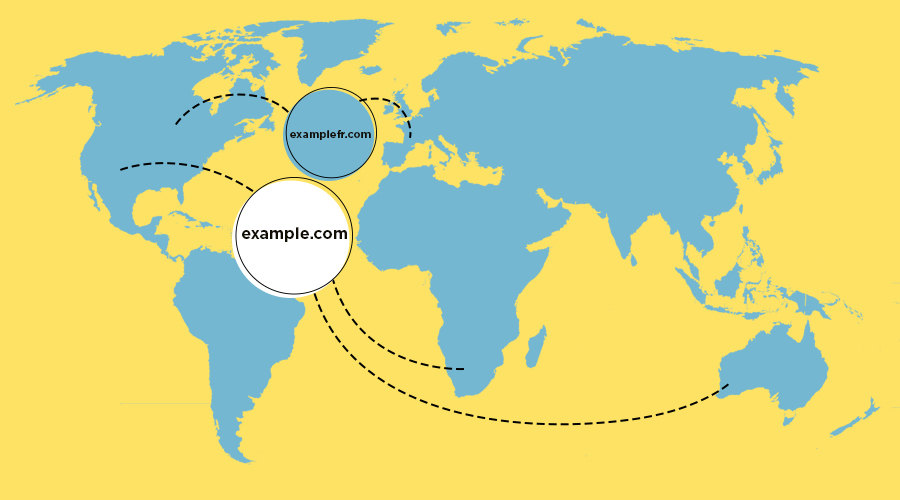
With separate domains, the search authority gained by links is not shared between websites in different languages.
Considerations
- If your domain name is the same as your brand-name, then this may not be a good option.
- If your products are marketed under a different brand name in another country, then this might be your best bet
- Further, if your main domain name is difficult to understand in the target market or it has some embarrassing meaning in that language, then it might be best to set up a website with a different domain name.
From the experts . . .
Lee Vann—Chief Strategy Officer
Captura Group Hispanic Digital Marketing Agency
Q: How should companies target the Hispanic market in the USA with their URL?
Vann: “When considering a URL for your Hispanic online marketing program, we recommend a dedicated branded URL. This strategy will lend credibility, familiarity and provide a simple point of access to your website. There are, however, some cases where branded URLs are not appropriate—for example, when the main objective of a Website is not to build a brand but rather to support a particular program.”

Having completely different domains for the websites in each language indicates a clear independence between the sites.
2. ccTLD, Pros and Cons and Considerations
Example: www.example.uk vs. www.example.mx
Pro
- Clear division between websites in various languages: Like the previous method, using the ccTLDs to indicate language implies a high level of independence between the websites in various language versions.
- Local hosting: You can host the website in each target region so the web pages will load faster in each region.
- Geotargeting for SEO: This method typically gives the strongest indication to search engines which region the website targets. Especially in some markets—such as China—it can make a big difference for SEO.

This map shows some of the ccTLDs in use around the world.
Cons
- Expensive: Setting up sites on separate ccTLDs is expensive.
- Labor intensive: Every site must be managed separately. Every ccTLD must be acquired separately.
- No sharing cookies: The separate sites will not share cookies (without some magic), so if someone logs in to one site, they won’t be automatically signed in on the second site.
Considerations
- Strictly speaking, the ccTLD refers to the country, not the language. Language is part of the mix, but it’s important to keep this distinction clear. The ccTLD would not be appropriate for targeting other language speakers in your own country. So for example, it would not be appropriate to use example.mx or example.es to target Latinos in the US market.
- Neil Patel says about ccTLDs, “This is the best option for country targeting with large sites.”
- While ccTLDs indicate countries, some ccTLDs have become commonly used for other reasons. For example, maybe together with the rest of the URL they spell a word. Probably the most common example of this is .ly. Although it is actually the ccTLD for Libya, it has become popular for a number of companies, especially URL shortening services such as adf.ly, bit.ly, and ow.ly.
- While the ccTLD certainly helps with geotargeting for search engines, there are other indicators—such as hreflang tags, meta information, and sitemaps—you can use to indicate to Google and other search engines which region you are targeting.
From the experts . . .
Amanda Koehler—Director of Digital Marketing & Strategy
Northwoods Web Solutions
Q: Why might a company want to use ccTLDs?
Koehler: “If you are building international websites, ccTLDs are important because they establish better localization for your websites. Search engines in each country want to provide localized results and if you use ccTLDs it is a good signal to the search engines that you intend for this site to cater to that local audience. Beyond search engines, users in those countries will see the ccTLD and feel confident that your company has a solid establishment in their country, and therefore will be more likely to purchase your products or services.”
3. Subdomain, Pros and Cons and Considerations
Example: fr.example.com vs. mx.example.com
Pro
- Budget-friendly: There’s no need to purchase separate domains. Also depending on whether you choose to have local hosting for every region or not, your hosting costs could be lower as well.
- Local hosting: You can host the website in each target region so the webpages will load faster in each region.
- Share Cookies: Cookies can be shared across language versions, meaning that a customer can log in with English and then switch to the German site and remain logged in.
Cons
- No sharing SEO ranking: The separate sites will not help each other with SEO ranking much. If your English website is already ranking very highly, it won’t do very much to increase the ranking of your Spanish website. Chris Berkley says, “Google has stated that their search engine is indifferent to subdomains vs. subfolders, but the SEO community has repeatedly found that to be false. Industry thought-leader Moz moved their content from a subdomain to a subfolder and saw measurable increases just as a result of that move.”
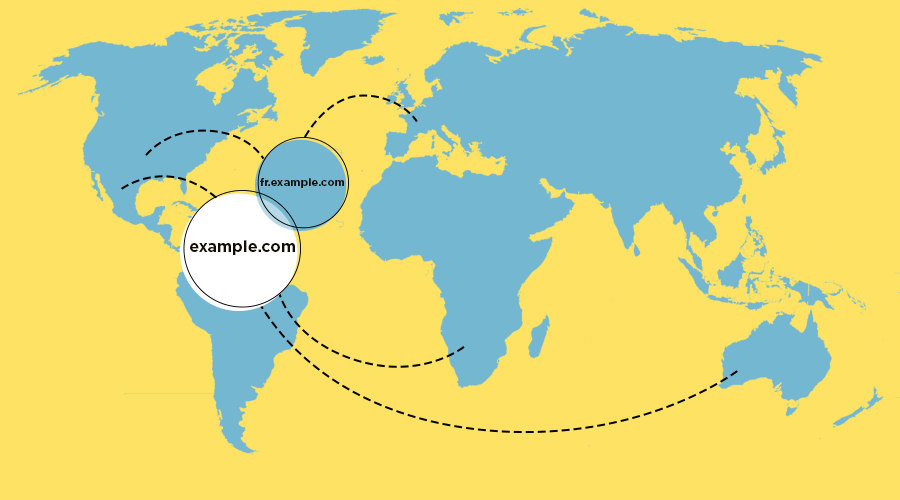
Search authority gained by one subdomain has a limited effect on other subdomains.
Considerations
- Using subdomains to organize languages implies a greater division between the sites than organizing with subdirectories would do. Jenny Halasz at Search Engine Journal gives the example of Disney. “They have cars.disney.com, videos.disney.com, disneyparks.disney.com, princess.disney.com… Each one serves a very different purpose.” She said, “Each subdomain basically functions as a separate “business” within the overall corporation.” Language subdomains likewise imply some division between the sites.
From the experts . . .
Kaitlin McMichael—Owner
Kate Ideas Marketing
Q: For SEO search ranking, should you use subdomains or should you choose subdirectories to organize your languages?
McMichael: “A subdomain, even a geotargeted subdomain, in general is seen as a separate website to a search engine. It is possible that search engines use some criteria to determine that subdomains are similar enough that they are seen as separate sites, but I have heard so many examples of companies that migrated their subdomain structure to a sub-folder structure on one domain, and seen SEO benefits. I have also experienced that myself with the brands I’ve worked on.
“It is much safer, in my perspective, to build your international SEO strategy with [subdirectories] rather than subdomains. The exception are large international brands that are well-known enough that they can do whatever they want and be successful. For example, Ikea, Amazon, GE: these brands could choose just about any international SEO site structure and be successful.
“For smaller brands, it’s important to take into consideration all the work that will have to go into building that website’s authority, or in your example, each of these subdomains would need to gain authority for each region. But each company needs to decide what is right for them.
“A [subdirectory] approach might not be the right approach if you have massive e-commerce sites, for example. You might want to consider subdomains or ccTLDs (country-coded top-level domains) instead. One reason for this is that separate sites may be given more crawl budget than a combined site under sub-folders. One way to validate this is to see whether bot crawling behavior in log files changes based on whether you have traffic on one domain, multiple subdomains, or multiple ccTLDs. In my experience, separate domains have the advantage of getting crawled more often than one domain.”
4. Subdirectory, Pros and Cons and Considerations
Example: www.example.com/fr vs. www.example.com/mx
Pros
- Shared search ranking: All links that links out to subdirectories (or webpages) on your site are all pointing to the same domain. The power that those links give is accumulated by your domain.
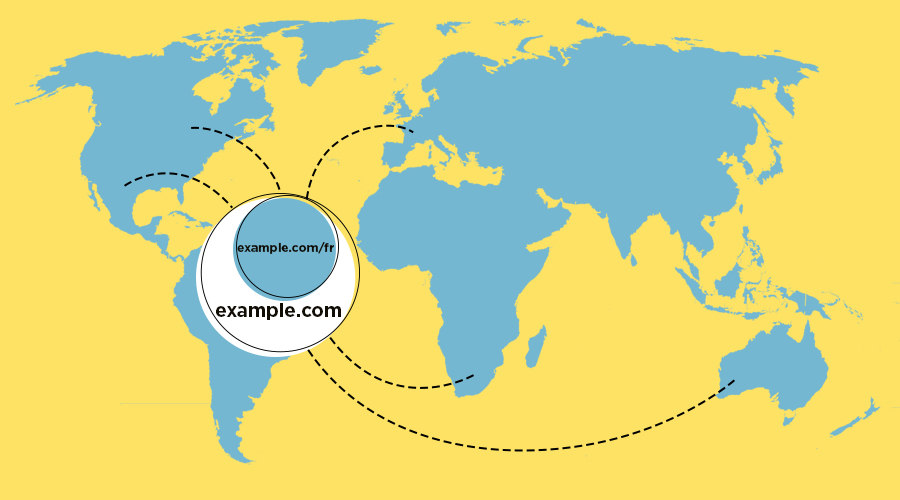
When languages are organized by subdirectory, all links pointing to pages in any language on your domain add search authority to your domain.
- Budget friendly: This method is much cheaper than purchasing and maintaining several ccTLDs and hosting in several locations around the globe.
- Less labor intensive: With languages separated into subdirectories you truly have to maintain only a single website with several languages on it, not separate websites with several languages.
Cons
- Centralized hosting: You cannot host your various language websites in your target regions. Well, actually there are discussions on the technical forums on how to do that using a reverse proxy. However, typically when companies want to host locally, they use subdomains or one of the other above methods.
From the experts . . .
Steven van Vessum—VP of Community
ContentKing
Q: Should you translate the URL path (the names of the subdirectories) as well? Or leave them in English? In other words, should you have www.example.com/
van Vessum: “I’d always localize URLs as well, because that leads to the best possible click-through-rate (CTR). Your potential visitors need to make a decision on Google’s result page what website to go for. We strongly believe the one that delivers the best localization has an advantage over the others.”
Q: Your company chose to have separate ccTLDs for each language. Why?
van Vessum: “That’s a great question, because the first response people in digital marketing would have is to put the entire multilingual site on one domain. While that would have helped us rank faster initially, it would have really hurt conversions too. We thought a truly localized approach would be the best approach ROI-wise (you need to look beyond just rankings), and I think we made the right call :)”
Considerations
- If you use this method, set up your subdirectories in Google search console with individual accounts so that you can analyze their traffic separately.
- If you are targeting different regions, then be sure to tell Google which regions you are targeting. In the Google Search Console, set each subdirectory up with the appropriate location using the geotargeting tool. According to WooRank, “Since subdirectories can be somewhat ambiguous when it comes to determine language vs. region targeting (is /fr/ targeting the French language or is it targeting France?), use Google Search Console to geo-target each subfolder.”
From the experts . . .
Courtney Harrington—Head Of Marketing
WooRank
Q: If a small company is targeting other language groups in its own home country, how would you recommend that it organize the various languages in its URL structure?
Harrington: “It would be best to use a similar URL structure to WooRank, i.e. /en, /fr, /de, etc. After you’ve set the URL structure, use hreflang to tie them all together. So, an example for Belgium, a country that includes several language groups, would be:
<link rel=“alternate” href=“https://example.com/fr” hreflang=“fr-be” />
<link rel=“alternate” href=“https://example.com/de” hreflang=“de-be” />
<link rel=“alternate” href=“https://example.com/nl” hreflang=“nl-be” />
“We have a useful guide about hreflang and SEO that elaborates this point for domestic language groups.”
5. Query String (URL Parameter), Pros and Cons and Considerations
Example: www.example.com/
Pros
- Zero. Zilch. Nope. Nada . . .: Well, actually Google organizes its support documentation website into various languages with query strings (or URL parameters), so they must have some reason to do so. Nevertheless, most experts recommend against using query strings to indicate language.
Cons
- Confusing: They can look confusing to users.
- Hurt search ranking: They can cause a number of problems for search engine crawlers, resulting in a hit to your search rankings.
Considerations
- Avoid this method unless you have a good reason to do otherwise.
Read More
How Multilingual SEO Can Set Your Brand on the Road to International Success
Don’t Let This Translation Mistake Torpedo Your Search Engine Rankings!
The Hybrid Method
When we say “hybrid method” we are referring to a company’s use of several different multilingual URL methods at the same time to organize a website.
Why use the hybrid method?
Reason 1: Reality Knocks
Sometimes the use of the hybrid “method” may be less of a use of a method and more the result of reality messing up a company’s idealistic plans.
For example the company may use ccTLDs for all their other sites, but when they expand to China, they find out that they cannot use .cn without having a business license in China.
Or they may find that someone else is already squatting on a domain they need.

As Forrest Gump says, “It happens.” Sometimes complications arise and make it impossible to for you to have a completely consistent URL structure for all languages and regions. In these cases you may need to use a hybrid approach to URL structure.
Reason 2: Company Structure
Other times the hybrid method may indicate something about the structure of the company.
For example the company may have a multilingual division in the US, e.g. example.com/en and example.com/es.
But then it may have a separate corporate entity in Spain which has its own domain, e.g. www.examplespain.com or www.example.es.
Reason 3: Region Vs. Language
A third reason to use more than one method at one time would be to distinguish between regional targeting and language targeting. So you could use ccTLDs to indicate countries and then use subdirectories to indicate languages.
For example, Yoast suggests that if you have a subsidiary in Canada with English and French speaking customers, you might have URLs like this:
example.ca/en
example.ca/fr
But then again, it’s not required to use the hybrid method to target regions and languages. You could have the same effect by using only subdirectories like this:
example.com/en-ca
example.com/fr-ca
For a real world example of this, check out the Stripe website. If you go to https://stripe.com/en-jp you will get an English language website intended for customers located in Japan. Scroll down to the bottom of the page to choose your region and language with the language selector.
Share This Huge Article on Social Media!
Share with all your friends by clicking on a social sharing button below.
Use Hybrid Method With Redirects
Even if you decide to use a hybrid approach, it’s always possible to set up separate URLs which all redirect into your chosen URL structure scheme. For example, www.segurosocial.gov redirects to www.ssa.gov/
This can be done to maintain the consistency of having all languages in subdirectories while still getting international SEO benefits of separate domains.
Regardless of the URL structure you choose for your localized website, the most important thing to remember is that you should know why you chose the structure you did and to the best of your ability ensure that you keep the scheme consistent.
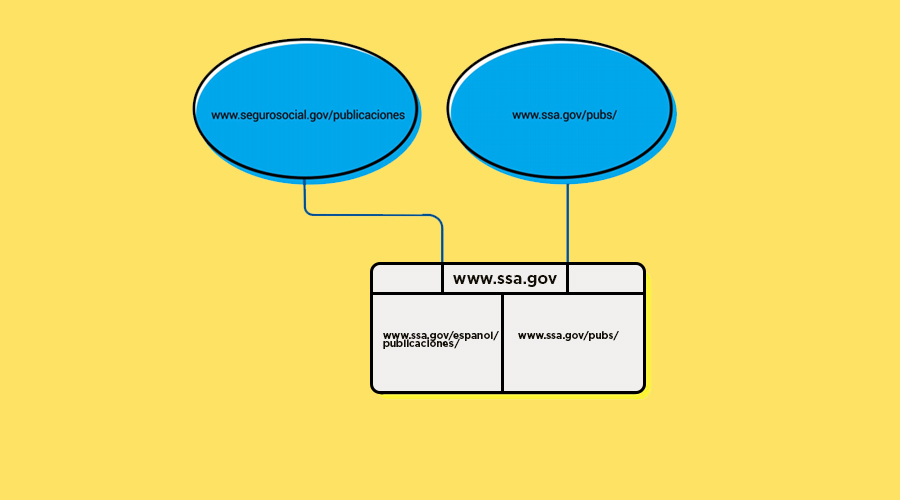
The U.S. Social Security Administration has a special domain name for Hispanic visitors: www.segurosocial.gov. However, when visitors type www.segurosocial.gov into their browser, they are immediately redirected to www.ssa.gov/
General Considerations
Technical limitations
Technical limitations of your technology may determine how you structure your URL. “If you’re using Shopify for example, you’ll need to set up new Shopify storefronts for each international version (unless you want to use a plugin to rewrite currencies and prices through JavaScript),” says Dan Taylor at Search Engine Journal. “This means you’re likely going to need to use different ccTLDs or domains while injecting hreflang through Shopify’s theme liquid.”
URLs are for People
Remember, technically URLs are for humans. If computers had their druthers, you’d just enter a series of numbers to visit a website.
So URLs should be easy to read and easy to understand. It won’t help your users if you make them complicated.
Further, remember that a certain number of people will directly edit the URL in their browser address bar to change the language. That means that if you follow a logical and consistent URL scheme, it will be possible for people to jump between different languages on your site by changing the language indicator in the URL. If you are inconsistent between languages, then you may frustrate these users.
Consider Best Practices for Your Target Markets
Particular countries might involve special considerations. Here are some examples:
Japan: There is little evidence that using Japan’s ccTLD improves SEO in the region. This goes for both of Japan’s most popular search engines — Google Japan and Yahoo! Japan. Further, using Japanese characters in your file path can be beneficial.
Russia: As of April 2020 Yandex was the second most popular search engine in Russia after Google (Yandex 42%, Google 55%). Yandex places value on keywords in the path. Therefore, you might want to put your keywords in the path in Russian rather than using English words.
China: Baidu is the top search engine in China with about 70% of searches in China. It has trouble crawling URLs with parameters, so if you want to attract Chinese search traffic, don’t use parameters for languages!
You can use Chinese pinyin in the path but some Chinese characters may cause issues with encoding, which will make the path unreadable.
Baidu prefers websites with the .cn ccTLD. But, if you want to use the .cn ccTLD, you have to have a Chinese business license.
Finally, local hosting is especially important for targeting China not only for sake of speed but also for sake of ranking on Baidu.
Like the Article?
Click here to share on Twitter>>
Tweet
Click here to follow IVANNOVATION on Twitter and be first to learn about our new content>> Follow @ivannovation
Targeting
The ccTLD gives a strong clue to Google about what region is targeted, but that is not by far the only clue Google and other search engines consider. Make sure you make use of all methods available to you to ensure that your website’s pages are targeted to the right region and the right language.
One method is the hreflang tag, which is added to an HTML page’s header in order to tell search engines what language and/or region the page targets.
<link rel="alternate" hreflang="en-us" href="http://www.example.com/page.html" />
<link rel="alternate" hreflang="fr-fr" href="http://fr-fr.example.com/page.html" />
<link rel="alternate" hreflang="es-mx" href="http://es-mx.example.com/page.html" />
The hreflang tags also prevent Google from considering your various language versions as duplicate content.
Other Resources:
Use this to search your site for hreflang errors: https://support.google.com/
Read this to learn how to indicate to Google what language you are targeting based on hreflang tags: https://support.google.com/
Unlike Google, Bing prefers to get your targeting information from a “content-language” meta tag in your webpage’s HTML head section.
Conclusion
You know your product or service has the potential to achieve global success. But global success won’t happen on accident; it requires a series of skillful, informed steps. One of those key steps is having a multilingual website that is honed for international SEO and for making a good impression on your target customers no matter where they live or which language they speak.
Deciding the appropriate URL structure for your multilingual site lays the foundation. It affects the cost, usability, and SEO of your site, and it affects the way the site evolves into the future.
The best time to involve experts on decisions like this is at the very beginning before an English site has even been developed.
Warning
The best time to think about localization is even before beginning work on the English website. In this way foundational steps can be taken to ensure that the website can be localized more easily later.
The second best time is after the English site has been built but before starting to localize into other languages.
The worst time to think about consulting with experts is after a series of costly mistakes have already been made. But still, later is better than never!
IVANNOVATION has been focusing on software and website localization for more than two decades and has helped millions of readers understand web content that was originally published in another language. It has helped companies land lucrative deals in countries around the world due in part to excellent localized content.
Some companies have global aspirations and take steps to make their intentions a reality. Take a first step to make your global aspiration a reality; contact us to discuss localizing your website.
Let’s Talk Website Localization
Set up a call or meeting with one of our localization specialists and get a quote for your project today.
Get a Free QuoteDarren Jansen, Business development and content manager for IVANNOVATION has a lifetime love for tech and languages. At IVANNOVATION he helps software developers get professional localization for their apps, software, and websites. On his time away from the office, he can be found hiking the Carolina wilderness or reading Chinese literature.




Great article! You summarised this very clear and it has helped me alot! Thanks for sharing 🙂
👍👍😊
Thanks for the valuable information.
👍😁👍
Your content is so underrated! Love how you gave us this helpful guide to build our URL structure. Thank you for this Darren, keep writing more blog 👍
Appreciate the kind words!